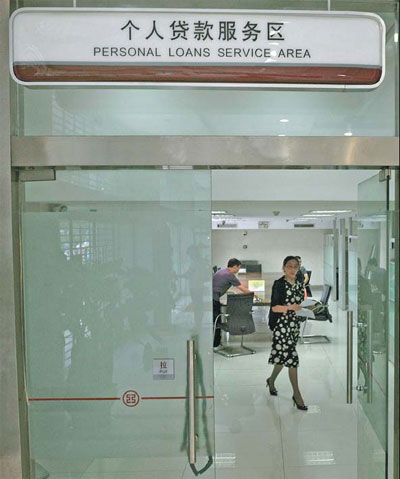New yuan loans hit August high
|
The personal loans service area of an Industrial and Commercial Bank of China Ltd branch in Nanjing, Jiangsu province. Provided to China Daily |
Analysts attribute surge to rise in personal lending, project approvals
China's lenders extended record high new yuan loans last month compared with any previous August as the government seeks financial support for new rounds of investment projects intended to spur economic growth.
New yuan lending reached 703.9 billion yuan ($111 billion) last month, up 155.5 billion from the same period last year, the People's Bank of China said on Tuesday, with the figure beating market expectations of around 600 billion yuan.
"The rapid lending growth in August shows that borrowing demand has started to rise after the government accelerated the approval of infrastructure construction projects. In addition, a more relaxed monetary policy is also prompting more bank loans," said Zhou Jingtong, a senior analyst at the Bank of China.
New corporate lending maturing in more than one year increased by 28.3 billion yuan from a month earlier, pulled up by increased investment in construction projects, said E Yongjian, an analyst at the Bank of Communications.
"But medium- and long-term corporate lending is still lower than the historic average. There is no substantial rise in corporate lending."
He said the jump is mainly attributable to increased home purchases in recent months and reflects a surge in individual lending related to the property market, which may not continue in the coming months.
Medium- and long-term consumer loans increased by 165.7 billion yuan last month, up 47.7 billion yuan from July, the biggest rise since April 2011.
Concerns over lending growth became increasingly intense after lenders lent just 540.1 billion yuan in July, the lowest level since October 2011.
Analysts have questioned whether the investment plans to stimulate the economy would work if they fail to get sufficient financial backing.
The National Development and Reform Commission has approved subway, road, port and other infrastructure construction projects valued at more than 1 trillion yuan in recent days. Before that, local officials announced investment plans valued at more than 7 trillion yuan.
"Banks have become more prudent when extending loans as they're faced with pressure from deteriorating asset quality," said Guo Tianyong, banking research director at the Central University of Finance and Economics.
By the end of June, commercial banks' non-performing loans reached 456.4 billion yuan, while special-mention loans - debt that could potentially turn sour - were at 1.46 trillion yuan.
Xu Xiaonian, a finance professor at the China Europe International Business School, said that China must be wary of the great risk that commercial banks are becoming "policy banks" again as the government attempts to make them lend more to those projects while asset quality pressure is already very high.
"We shouldn't forget the price we paid for the huge non-performing loans piled up by lenders 10 years ago, and how much effort we've made to change those banks into modern commercial lenders."
M2, a broad measure of money supply that covers cash in circulation and all deposits, rose 13.5 percent year-on-year by the end of August, down 0.4 percentage point from a month earlier, according to the central bank.
Total social financing, which includes loans, bond and stock sales, increased 16 percent year-on-year in August to 1.24 trillion yuan, compared with 1.04 trillion yuan in July.
Lu Zhengwei, chief economist at Industrial Bank, said a more than 100 billion yuan year-on-year increase in trust loans last month is more eye-catching than the greater-than-expected new bank loans. New trust loans stood at 118 billion yuan in August.
"Trust loans probably have become a shadow channel for local construction projects to generate enough capital," he said.
"Since last year, we have continuously expected Chinese policymakers to 'tolerate slow growth' and to 'aim at stabilizing, instead of boosting growth'. Recent data, however, suggest that our previous growth forecasts were still too optimistic," said Huang Yiping, chief economist for emerging Asia at the investment banking division of Barclays Bank Plc.
He has lowered the forecast for China's GDP growth rate throughout 2012 to 7.5 percent, the weakest since 1990, from the previous 7.9 percent.
"It is time to switch policy operation tactics by cutting (lenders') reserve requirement ratios to arrest a fast decelerating economy, while reverse repo operations could act as a correction mechanism to fine-tune liquidity conditions in China," said the Australia and New Zealand Banking Group Ltd in a research note.
wangxiaotian@chinadaily.com.cn



















